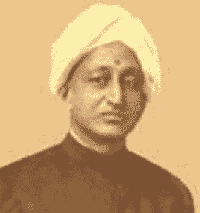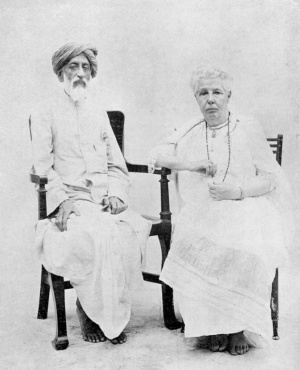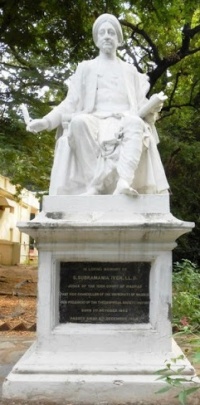S. Subramania Iyer

Sir Subbier Subramania Iyer KCIE (Tamil: சுப்பையர் சுப்பிரமணிய ஐயர்) (1 October 1842 – 5 December 1924) was an Indian lawyer, jurist, and freedom fighter who worked with Annie Besant to establish the Indian Home Rule Movement.
Early Days
Subbaiyar Subramania Iyer was born of Brahman parents on 1 October 1842 in Madura (now Madurai) District, South India. He was brought up amid the enlivening and chastening circumstances of a high-caste Hindu family and hence had access to education in English very early in life. His mind was thus open in its formative period to the influences introduced by the West. His father Subbaiyar was a trusted Vakil or agent of the Zamindar of Ramnad (Madura District). He died in 1844 when Subramaniam was only two years old. Young Subramaniam had his early schooling in a Christian Mission, then in an English school, and in 1856 he entered Zilla High School. He was successful in various fields and passed the highest examination in that school in 1859. His name appeared in the official Gazette and caught the eye of the Collector of the District, and soon the successful young man started his career in Government service as a clerk.
While serving as a clerk, Subramania Iyer passed the examination to become a pleader at the head of the list for the Madras Presidency, but he was not given permission to practise. However, when the Criminal Procedure Code came into force in 1862, his legal qualifications found recognition.
Career As A Lawyer
The year 1857 saw the establishment of the University of Madras and in 1864 the High Court in Madras came into existence. Under its rules anyone who took the Bachelor of Law degree at Madras University and studied for a year under a practitioner of the High Court could be admitted to plead before it. Subramania Iyer took the opportunity to go in for higher studies and became a student once again. Though working all day in the office, he passed the Matriculation examination in 1865, Fellow of Arts in 1866 and Bachelor of Law in 1868 — all by private study. These added qualifications secured him promotion to the office of Tahsildar, but he soon resigned and apprenticed himself to an English Barrister who was also the Official Reporter to the High Court. Subramania Iyer became a reporter to the High Court himself and was formally admitted to the Bar in 1869. Within a few months he was able to start his career and returned to Madura where he practised for fourteen years.
In 1870, as a young man of twenty-eight, blossoming into a leader of the Bar, he was appointed the Municipal Commissioner of Madura, in which capacity he did much for that city. He was also a member of the Madura District Board. In 1873 he won a suit against a temple committee for discrepancies in their accounts, after which he strove hard throughout his life to introduce rectitude into the management of temples. He founded the Dharma Rakshana Sabha for carrying out reforms and for the redress of grievances in the management of Hindu temples. He was also the pioneer of a movement which culminated in the passing of the Hindu Religious Endowments Act and the establishment of the Hindu Religious Endowments Board. Later, as a Judge, he advocated that surplus temple funds be used for religious education and amenities for pilgrims. In 1875, when H. M. the late Emperor Edward visited Madura as Prince of Wales, Subramania Iyer was chosen to be the spokesman of the town and presented its loyal address of welcome. In 1877, recognition of his work came to Mr Iyer in the form of a Certificate of Merit awarded by Lord Lytton at Delhi. In 1884 Sir M. E. Grant Duff, Governor of Madras, visited Madura and, recognizing the worth of Subramania Iyer, nominated him a non-official member of the Madras Legislative Council.
The year 1884 was a turning point in Subramania Iyer’s life. He lost his wife and had to come to terms with his grief. He came into contact with Col. H. S. Olcott and joined The Theosophical Society, of which he remained a staunch and loyal member till the end. It was in Madras that he first met Mr T. Subba Row, a Hindu scholar and Theosophist, who much impressed him.
In December 1884 Subramania Iyer was one of the seventeen men of the Provisional Committee formed in Madras that began the long struggle for India’s freedom and evolved the scheme of a national assembly. In 1885 the Indian National Congress held its first formal session in Bombay. Mr Iyer, as one of the co-founders, contributed significant information about the working of the Legislative Councils. This is one of the instances of Mr Iyer’s advocacy of popular government — long before the arrival of Annie Besant in India. In the same year Mr Iyer moved to Madras and took up practice in the High Court, thus widening the sphere of his activity. He was also appointed a Fellow of the University. From this time onwards he was a constant adviser of the President of The Theosophical Society, Col. Olcott, and was made a member of the Executive Committee.
In 1887, the British Government gave expression to their appreciation of Subramania Iyer’s work; he became the first Indian to be appointed Government Pleader and Public Prosecutor. Owing to his unique abilities, high character and distinction, Mr Iyer was able to break down the prevalent racial prejudice and be accepted, and to enter for the first time into what had been regarded as the close preserve of the Europeans. At the end of his first term of office the Chief Justice wrote him a special letter of appreciation for his work. In 1895 he rose to the Bench of Madras High Court and till his retirement in 1907 he continued to be an honoured Judge, thrice being raised to Acting Chief Justice — in 1899, 1903 and 1906. The Privy Council recognized him as ‘a Hindu lawyer of great distinction’ and showed deference to his views; the public idolized him as one who never failed to temper justice with mercy.
The British Government, recognizing his brilliant work in his profession and his contribution to public welfare as a non-official member of the Legislative Council, made him a C.I.E. — ‘Commander of the Most Eminent Order of the Indian Empire’ — in 1889. In 1891 he was given the Indian title of ‘Diwan Bahadur’, and in 1900 he was made a K.C.I.E. — ‘Knight Commander of the Indian Empire’ — and became Sir Subramania Iyer. He retired from the office of Judge in November 1907, owing to failing eyesight.

Work With Theosophical Society

Having joined The Theosophical Society in the early 1880s Subramania Iyer threw himself into active work for the Movement. He was the Founder-President of the Madura Lodge of The Theosophical Society till 1885 when he settled in Madras.
In Madras, he was made a member of the inner committee of seven which really managed all the affairs of the Society. Col. H. S. Olcott, the President of the Theosophical Society, consulted him upon all points requiring decision, and placed great reliance on his judgement. He was also a member of the committee appointed to investigate the Coulomb affair, and it was largely owing to his advice that Madame Blavatsky was dissuaded from prosecuting them. In 1893, he met Annie Besant at the Annual Convention at Adyar and remained her staunch friend, working with her in all her various activities of nation-building and Theosophy. He was the co-founder of the Young Men's Indian Association with Dr Besant, and an active worker and Honorary President of the National Home Rule League till he passed away. Annie Besant wrote of him:
'He joined The Theosophical Society in its early days, when it was despised and rejected of men, shed lustre on it by his brilliant intelligence, his spotless life, and his profound devotion to Helena Petrovna Blavatsky. He stood by her through the infamous Coulomb attack, and was a member of the Committee which investigated the charges and declared her innocent of the accusation of fraudulent phenomena brought against her.'
Sir Subramania Iyer was the Recording Secretary (1905–6) and assisted Col. Olcott when the Theosophical Society was incorporated on 3 April 1905 at Madras. He was appointed Vice-President in 1907 when Dr. Besant took the office of President of The Theosophical Society. In 1911 when Mr. Sinnett decided to rejoin the Society she offered him the position of Vice-President, and cabled to Sir Subramania Iyer to ask if he were willing to resign to make this appointment possible, and he gallantly and immediately agreed to do so.
The Theosophical Society and its members comprised a significant block of the SPNE's (Society for Promotion of National Education) membership. Among the Theosophists most active in education were: Annie Besant, George S. Arundale, Francesca Arundale, James H. Cousins, Margaret Cousins, Fritz Kunz, Ernest Wood, Mary K. Neff, C. Jinarājadāsa, Nilakanta Sri Ram, Bhagirathi Sri Ram, B. P. Wadia, Hirendranath Datta, Sir S. Subramania Iyer, and P. K. Subramania Iyer. Other workers included Mr. Rama Rao, Mr. Trilokekar, Miss Herington, Mr. Huidekoper and P. K. Telang.[1]
In 1917, Sir Subramania Iyer took the bold step of addressing President Woodrow Wilson of the United States on British misrule in India, citing particularly the incarceration of Annie Besant, G. S. Arundale and B. P. Wadia. He requested Mr. Wilson to use America’s influence for Indian Home Rule. He also surrendered all the honours conferred on him by the British Government as, in Dr Besant’s words, "he would not wear an honour given by a Government which had struck so shrewd a blow at his country’s liberties."
He was unceasing in his efforts to obtain the release of his colleagues. The agitation was successful and resulted in their release within three months. He continued to be actively involved in the work of The Theosophical Society and various other causes for his country till his last days.
Honors and Tributes
Several honors were accorded to the judge by the British Government, recognizing his brilliant work in his profession and his contribution to public welfare as a non-official member of the Legislative Council. These included:
- C.I.E. or Commander of the Most Eminent Order of the Indian Empire, was awarded in 1889.
- Diwan Bahadur, was awarded in 1891. An Indian title equivalent to the "Civil Division" of the British Order of the Bath, it was awarded to individuals who had performed great service to the nation. Dewan literally means Prime Minister and Bahadur means brave.
- K.C.I.E. or Knight Commander of the Indian Empire, was awarded in 1900, making him "Sir" Subramania Iyer.
After Iyer wrote to American President Wilson, the British Secretary of State for India, Mr. Montagu, made clear that while Iyer's conduct would be excused this time, he should not again interfere in the Government of India.
Whereupon Sir Subramaniya Iyer wrote to the Government of Madras giving up his titles of K.C.I.E. and of Diwan Bahadur, and returning the insignia [badge] of the order. After the contemptuous terms which so responsible a Minister of the Crown saw fit to use toward him in the House of Commons it was impossible for him with any self-respect to continue to avail himself of the honor of being a title-holder.[2]
A large statue was placed by the headquarters building in Adyar.
The March, 1943 issue of The Theosophist was dedicated to his memory.
Publications
Sir Subramania Iyer published many articles in Annie Besant's newspaper New India and in Theosophical journals, the two most important being "Rishi Gârgyâyana's Pranava-vâda" and "An Esoteric Organization in India," the latter being published as a book by the Modern Printing Works, Madras. His interests lay in social and educational reforms along with ancient Indian texts and he wrote on these subjects. The Union Index of Theosophical Periodicals lists 42 articles by or about Sir Subramania Iyer.
Being a keen student of Theosophy he was responsible for getting three important books published. The Roof Talks given by C. W. Leadbeater and Annie Besant contained a wealth of information, due to new clairvoyant research; these often developed from a question put by a student in an intimate circle. Sir Mani Iyer contributed generously to help in the publication of these Talks which became The Inner Life by C. W. Leadbeater. He was also one of the few in a small group who received private instruction from Mr T. Subba Row; the notes he made were published in the 1931 edition of A Collection of Esoteric Writings of T. Subba Row. Further, Sir Mani Iyer commissioned a shorthand writer to transcribe the lectures of T. Subba Row on the Bhagavadgitâ, given during the Theosophical Convention in 1886; these were published as a book entitled The Philosophy of the Bhagavadgitâ. These talks were deeply scholarly and mystical and Madame Blavatsky quoted extensively from this book in The Secret Doctrine. Hence Sir Subramania Iyer’s contribution to Theosophical literature, though indirect, was nevertheless valuable.
Last Days
Sir Subramania Iyer, after his retirement as Justice of the Madras Bench, concentrated on serving The Theosophical Society and his country, even while on his own spiritual quest. He took to the systematic investigation of many forms of meditation. Consequent to his spiritual pursuits and meditative practice he appeared to have attained certain occult powers, incompatible with a worldly life, and became a recluse. Doubtlessly his spiritual transformation was enkindled and fuelled in no small measure by his association with HPB, T. Subba Row, Dr Besant and The Theosophical Society. Dr Besant, wrote about Mani Iyer’s last days:
He was ill for very long, but to the end his splendid brain remained strong; the last few months were full of pain, but the dear old man remained patient throughout, only longing to go Home; and he went gladly to the Master he loved and served.
He passed away on 5 December 1924.
Sources
1.‘The Theosophical Centenary: Dr Subramania Iyer’, George S. Arundale and N. Sri Ram, The Theosophist, Vol. 64, No. 6, March 1943.
2.‘Dr Subramania Iyer’, Annie Besant, The Theosophist, Vol. 64, No. 6, March 1943.
3.Speeches and Writings of Dr (Sir) S. Subramania Iyer, S. R. Murthy & Co., Triplicane, Madras, 1918.
4.Dr Sir S. Subramania Iyer, Triplicane Theosophical Society, Diamond Jubilee, 1958.
5.Sir Subramania Iyer — A Sketch of his Life and Career, G. A. Natesan and Co., 1918.
6.Two Great Theosophists — Sir Subramania Iyer, K.C.I.E and A. P. Sinnett, Souvenir of the American Section of the Theosophical Society, Chicago, 1911.
7.‘Sir S. Subramania Aiyar — Some Reminiscences’, V. V. Srinivasa Aiyangar, The Hindu, Saturday, 4 January 1936.
8.‘A Theosophical Worthy’, C. W. Leadbeater, The Theosophist, Vol. 64, No. 6, March 1943.
9.‘A Distinguished Theosophist — Sir S. Subramania Iyer’, N. C. Ramanujachary, The Theosophist, Vol. 119, No. 6, March 1998.
10.‘Mani Iyer’, K. Balasubramania Iyer, The Theosophist, Vol. 64, No. 6, March 1943.